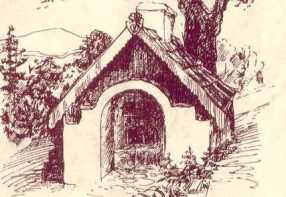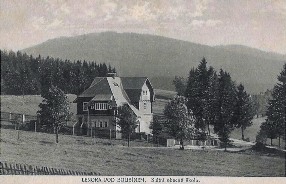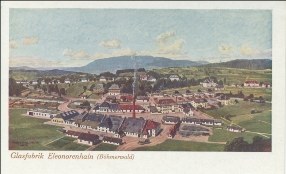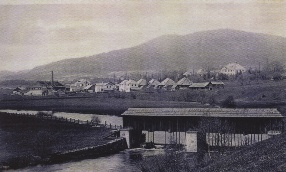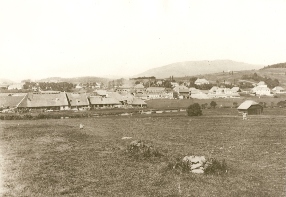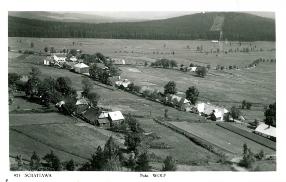HISTORY OF THE VILLAGE
The village of Lenora was founded as a settlement around one of the last glass- works established in the Šumava mountains by Jan Meyer in 1834. Later on the glass-works were taken over by Meyer's nephew Vilém Kralik.
The village was named Eleonorenhain after the Princess Eleonora (1812-1873), the wife of the lord of the estates John Adolf of Schwarzenberg. Czech translation of the name is "Eleonora's Paradise". Later on the village adopted Czech version of the name, Lenora. The main reason for establishment of the glass-works in the area consisted in huge reserves of wood on the slopes of Boubín mountain. However, timber harvesting from the hardly accessible area required costly landscape alterations. The region in vicinity of Boubín - formerly covered by wetland forests - rapidly changed into an important centre of glass-making. Later on, when the glass-making plant already started operation, its proprietor therefore had full right to say: "I could cover the whole region with silver coins - that much cost its adaptation."
In the second half of the 19th century the glass-works belonged amongst the largest and most up-to-date in Austria-Hungary. In the inter-war period, the glass-works exported up to ninety percent of the production, mainly to the United States but also to India, Britain and Belgium. After the World War II, the glass-works specialized in blown glassware and introduced to the market a completely new kind of art glass, co called "lenoár". Lenora glass-works was modernized in 1968. It was manufacturing products of lead crystal as well as clear and rich-ground glassware. Hand in hand with development of the glass-works the village also grew promisingly. In 1840 already, i.e. 6 years after its establishment, the village had 20 houses with 102 inhabitants. These glass-makers' houses with the original name „Schleiferhauser“ today represent one of the village's architectonic places of interest. The population was quickly growing and Lenora, though being founded as the last one of the surrounding villages, was becoming the largest one. The major demographic changes in the area occurred in respect with the displacement of German inhabitants after the World War II. For illustration: in 1930, before the World War II, Lenora had 820 inhabitants, in 1950 only 574 inhabitants and as at 31st December 2010 689 inhabitants. The situation was changing even more dramatically in the local municipality of Zátoň: 445 inhabitants in 1930, 188 inhabitants in 1950, and 66 inhabitants as at 31st December 2010.
The world-famous Lenora glass-works had operated successfully until 1996, when the last glass furnace died out. The plant was taken over by private proprietors, however never continued any production and the whole premises are currently in rather dreary condition. The end of glass making meant a substantial change in lives of the locals, who had previously been employed by the company. Today they have to commute to work. In spite of that, the footprints of glass-making tradition can be well perceived in the village. We can find here a museum of glass with lovely glassware made by local and other glass-makers, a glass-cutting shop or a glassware gallery. The smaller glass-works Barbora was in operation until 2009.
The history of the village of Lenora is closely linked with tourism, because it functioned as a starting point of trips into the neighbourhoods. A large and beautiful Touristenhaus hotel was built in 1885, and a cottage of the Czechoslovak Tourist Clubs followed in 1925. Tourist reputation of the village was due to its location in vicinity of Boubín forest and right by the Teplá Vltava, as well as to the passing railway line built at the turn of the 19th and 20th centuries.
The administrative area of Lenora also includes the villages of Houžná, Kaplice, Vlčí Jámy, and Zátoň.
The village of Houžná was founded in 1735. The original German name Hublern the most probably comes from the tradition and remains of gold mining - the hillocks called "hübln". In 1790 there were already 19 houses standing here. The Czech name of the village is derived from the Houžná stream, the name of which was documented in the 16th century already. One of the interesting houses in Houžná that has survived to date has No. 34. It is called Trewanihaus according to its Italian inhabitant Trewani ,who was manufacturing wooden sticks for matches here. Later on the building housed a paint-room of glassware for the Lenora glass-works.
Kaplice is a small settlement 3 km to east of Zátoň. It was named after the chapel dating from the 15th century. In 1910 there were 8 houses here with 61 inhabitants, while in 2010 only 4 permanently resident inhabitants were recorded. All the other houses serve to recreational purposes. The stream of Kaplice was used for floating of timber from Boubín forests to the Lenora glass-works and to the Vltava. Along the stream banks there are several hillocks as remainders of local gold panning.
The village of Vlčí Jámy was founded after termination of the Thirty Years' War, mainly because of 13 forest workers (so called Waldbauern) who penetrated to the place through deep forests and settled nearby the estuary of the Grassige Moldau (the Řasnice). Local manor proprietor founded several pits for trapping of wolves in 1677. From the name of the settlement - Vlčí Jámy (Wolves Pits, Wolfsgrub in German) it is obvious that the place was legendary for the increased occurrence of these animals. Nowadays there are 24 people living in Vlčí Jámy, the majority of whom works as agriculturists at local farm.
Zátoň ( Schattawa in German) lies at the altitude of 820 meters, right beneath Boubín on the southern sunny slope of the mountainous ridge Bázum. The Teplá Vltava runs through the valley. The first written record of Zátoň, which also belongs to the administrative area of Lenora, dates back to 1359. Many generations of the local inhabitants were devoted to timbering and stock-breeding. Surrounding forests long resisted the intensive economic activity, were abound in game and the countryside preserved its typical character. That is why in 1750 the then manor owner, Joseph Schwarzenberg, ordered to build a hunting lodge directly in the village in the place of former farmstead. Later on the building was turned in the forester's lodge and finally became the seat of forest district and the state enterprise Lesy ČR (Forests of the CR). From the order of John Adolf of Schwarzenberg a hunting lodge was built under the peak of Boubín in 1902. After the land reform of 1930, when family of Schwarzenbergs lost a part of their estates, the Prince John Adolf let dismount the lodge and transport it to the manor estates of Hluboká. All the Schwarzenberg family members were excellent managers. Among other things, they built a network of forest roads in the surroundings of Boubín, which has been serving to its purpose to date. Today, only 66 people are permanently resident in the village. Many buildings and cottages serve to recreational purposes.

